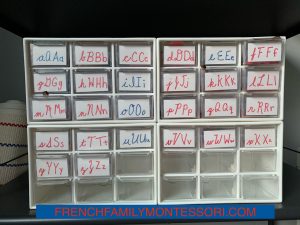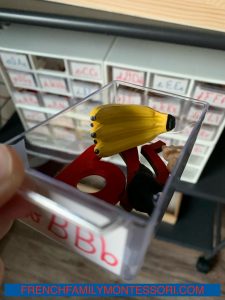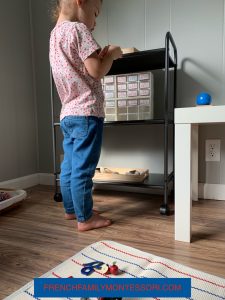Sound boxes are so awesome!
So what are they? It’s a material that allows the child, who is likely in the sensitive period for small objects, to be introduced to the moveable alphabet and phonic first letters of those objects. In other words, it helps them to learn the sounds that a letter makes through their knowledge of objects they are already familiar with (in Montessori we first teach phonic rather than the name of the letter).
It may be better understood as I share how I created E and V’s sound boxes.
I used these drawers (four, to be exact) and glued them together with gorilla glue. This allows the drawers to remain in order as well as makes them more sturdy.

I then labeled the drawers with the alphabet, going left to right, as this is how we prepare children to read. As I’ve shared in the last post, about our moveable alphabet DIY, I couldn’t decide between print or cursive, so we are currently doing both and I’ll follow their lead in which they prefer in case both are too much (I wrote them so that I can easily cover one or the other). While there are so many options when it comes to drawers, I picked ours because of the uniform size. Examples I’ve seen of drawers with various sized drawers seem confusing–they don’t go straight across but kind of go up and down.
In each drawer, I placed the corresponding moveable alphabet letter (if using the cursive moveable alphabet, some letters, such as /f/, stick out of the drawer a little) and small objects that begin with that letter that they are familiar with. The key being items that they are familiar with.
If I place a hummingbird in /b/, for bird, I would be setting my children up for failure, because they are aware that it’s a hummingbird, so it goes in /h/. I can put a butterfly in /b/, regardless of the type, because they aren’t familiar with the different types yet.

Another thing to consider is what you call objects in your home. While we use a pitcher, I know many families call it a jug. So we would put a miniature pitcher in /p/ but those families would place it in /j/, for jug.
Where did I get these items? I used Safari LTD toob figurines as well as their miniatures (I came across these, as well). Charms like these. We even went to Clair’s and found some earrings that had some items that we needed (ensuring that E and V could easily recognize what they are). Erasers, like these, are another great option.

Here are the items we currently have:
/a/: ant, apple
/b/: baby, bear
/c/: cat, carrot
/d/: dog, duck
/e/: elephant, egg
/f/: fly, fox
/g/: goose, goat, giraffe
/h/: horse, heart, hippopotamus
/i/: ice cube, ice cream
/j/: jelly, jar
/k/: key, koala
/l/: ladybug, lion
/m/: moon, mama
/n/: nest, nose
/o/: octopus, orange
/p/: pig, pear, pumpkin
/q/: queen, q-tip, question
/r/: rabbit, rooster, rainbow
/s/: snake, strawberry
/t/: trumpet, turkey, tomato
/u/: umbrella,
/v/: violin,
/w/: watermelon, water
/x/: xylophone, x-ray
/y/: yarn (Huge shoutout to Nicole Kavanaugh and a few lovely Instagram followers who suggested yarn as all I could think of was a yo-yo.)
/z/: zebra, zipper
Some of the objects listed above haven’t made their way into the boxes yet as they need a three-period lesson (post to come) to ensure that E and V both know what they are before coming across them there.
It’s important to observe and listen to the child, I’ll share a story that, if you follow us on Instagram, you may already be familiar with. E put the horse in /e/. She showed me that horse is /h/ but /e/ because “E likes horse.” She was going off the first phonic sound of the sentence rather than the word ‘horse’. Children never cease to surprise and amaze me at what they pick up.
What items would fill your sound boxes? Share below to inspire others.❤️
.
.
.
